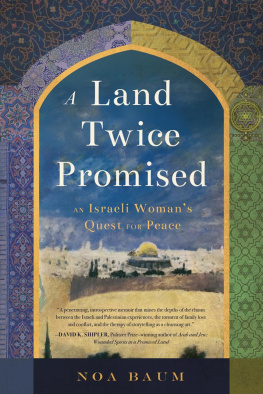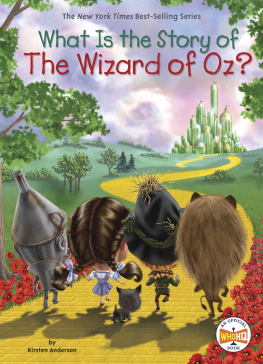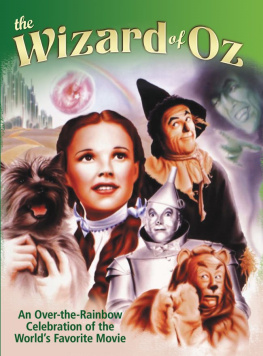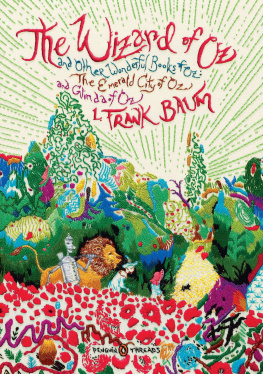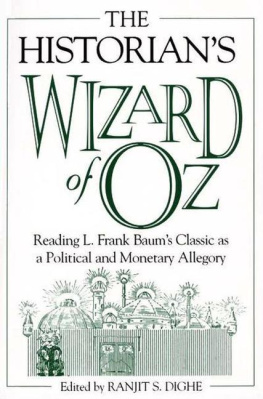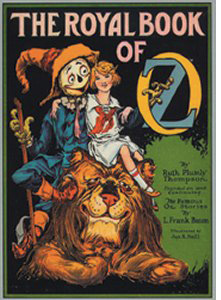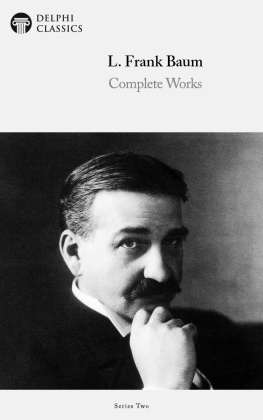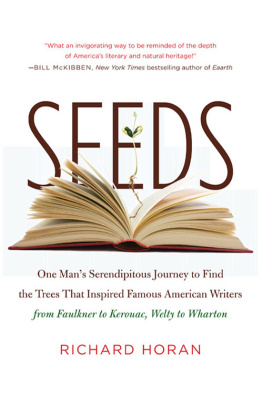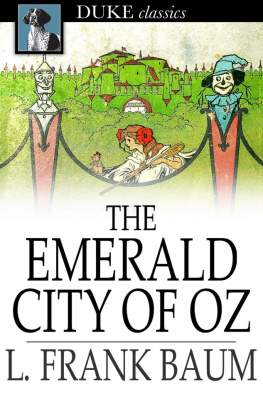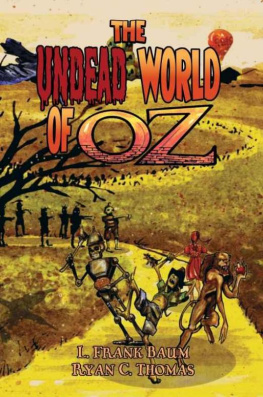Finding Oz
Evan I. Schwartz
How L. Frank Baum
Discovered the
Great American Story
HOUGHTON MIFFLIN HARCOURT
BOSTON NEW YORK
2009
Copyright 2009 by Evan I. Schwartz
ALL RIGHTS RESERVED
For information about permission to reproduce
selections from this book, write to Permissions,
Houghton Mifflin Harcourt Publishing Company,
215 Park Avenue South, New York, New York 10003.
www.hmhbooks.com
Library of Congress Cataloging-in-Publication Data
Schwartz, Evan I.
Finding Oz : how L. Frank Baum discovered the great
American story / Evan I. Schwartz.
p. cm.
Includes bibliographical references and index.
ISBN 978-0-547-05510-7
1. Baum, L. Frank (Lyman Frank), 18561919. Wizard of Oz.
2. Oz (Imaginary place) 3. Philosophy in literature. 4. Mythology
in literature. 5. Spirituality in literature. 6. Fantasy fiction,
AmericanHistory and criticism. I. Title.
PS 3503. A 923 W 5987 2009
813'.4 dc22 2008053296
Book design by Melissa Lotfy
Text is set in Goudy Old Style.
Printed in the United States of America
DOC 10 9 8 7 6 5 4 3 2 1
Photo credits appear on page 356.
To my daughters,
Lily and Michaela
CONTENTS
Prologue: America's Adventure ix
PART I
1. No Place Like Home 3
2. An Unexpected Journey 11
3. A Girl in a Man's World 27
4. Heart of a Tin Man 45
5. Roadblock 59
PART II
6. The Mythic Oilcan 81
7. Witch-hunting 93
8. Frontier of Hope and Fear 111
9. The Story Store 128
10. The Brainless and the Heartless 151
11. Field of Blood 170
PART III
12. The Golden Path 195
13. The Glimmering City 212
14. The Wizard's Challenge 228
15. The Witch Is Dead 242
16. This One Story 261
17. Home Again 283
Epilogue: A Great Awakening 295
Postscripts 299
Acknowledgments 319
Notes 322
Credits 356
Index 357
PROLOGUE: America's Adventure

The world of Oz, as created by L. Frank Baum, has become an adventureland of the heart and mind.
Then a strange thing happened.
L. FRANK BAUM,
The Wonderful Wizard of Oz
W HERE DO stories come from? Are fairytales a product of pure imagination or the result of one's own life experiences?
Are storybook characters and settings woven from thin air, or are they inspired by people we've met and places we've been?
Do great myths say only what appears in the text or on the screen, or do they speak of deeper wisdom and higher truth?
And can stories be invented in a single moment, or do they reveal themselves little by little over a lifetime?
In the strange case of a certain adventure fantasy, these mighty mysteries came into focus one day in 1898, when an unusual sequence of images leaped from one man's mind.
There was a gray Kansas pairie. A lively girl with a brave little dog. A terrifying twister. A mystical land ruled by both good and wicked witches. A colorful township of little people. A road of yellow bricks stretching through a dangerous frontier. A trio of comical charactersa scarecrow, a tin man, and a cowardly lionwho join the girl from Kansas on her quest, a journey to a magical city of emeralds controlled by a mysterious wizard. "The story really seemed to write itself," author L. Frank Baum told his publisher.
Baum relied on a favorite pencil as he put the tale to paper. By the fall of 1899 the pencil was just a stub, and he fastened it into a frame and surrounded it with a caption: "With this Pencil I wrote the ms. [manuscript] of The Emerald City. "He sealed the frame and hung it on the wall above the desk in the den of his Chicago home. The final name of the novel would have to be changed, as Baum soon found out. "The publisher believes that books with jewel names in their titles do not sell well," he lamented.
Frank was forty-four by the time the book hit stores in the year 1900, and this business of being an author of children's stories was still new to him. By then he had failed at so many wildly different pursuitsas a breeder of chickens, as an actor in stage plays, as a purveyor of petroleum products, as an owner of a variety store, as a secretary for a baseball team, as a publisher of a newspaper, as a traveling salesman of fine chinathat he might have simply given up on doing anything special with his life. If he had never experienced that one special moment that one day in 1898, he might even have gone on to succeed in his current full-time joband gone down in history as the founder of the National Association of Window Trimmers of America. But the truth was, even that effort wasn't going so well.
Yet it wasn't in Frank Baum's nature to get down on himself, and he became newly energized by each of his schemes, determined to "somehow manage to provide for those dependent on me." He was a sunny man, tall and handsome with a graceful gait and a deep, resonant voice. Prone to flights of fancy, he was lucky to have a wife who kept him grounded. Her name was Maud, and as a young beauty she had dropped out of a good college to marry Frank, only to face years of struggle, constantly uprooting their home in search of a better situation. Together they raised four active sons, boys who demanded that their father tell them stories every evening, stories that seemed to give their lives a sense of constancy.
Rounding out the household was Maud's mother, who lived with the Baums for months at a time. Even by the high standards of the world's most menacing mothers-in-law, she set herself apart. Her name was Matilda Joslyn Gage, and she reigned as the most radical and principled leader of the women's rights movement in America. Mrs. Gage railed against religious leaders and politicians for a living and was so controversial and so scary to some that she was deemed "an infidel," her activities called "satanic." She had warned her daughter that she'd be a "damn fool" to give up her schooling to marry this man who showed little promise of holding a steady occupationand for a long while she was right.
So Frank had to keep forging ahead, with the faith that something wonderful lurked beneath the surface of his failures, that something mystical swirled within the turbulence of his family, and something momentous stirred in America at large during this time of cyclonic change.
That something called him from his hometown in the East to an adventure out West, to the treeless Great Plains during the final days of the American frontier. Frank had tuned in enough to realize that he was traveling on his own journey of discovery, and he became fascinated with finding what spiritual sages had long called the True Self. But out there on the prairie, a land of killer tornadoes and deadly droughts, Frank came face-to-face with darkness and shadow, aspects of a mythic pattern of symbols and events that he encountered in his own life and times.
For too long he had suppressed his childhood dream of becoming a great writer, instead choosing to focus on the economic and social demands being placed on him. When such a choice is made, says mythologist Joseph Campbell, one's "vital powers disintegrate" and a would-be hero can become trapped by resentments and rationalizations "until he finds himself locked in the labyrinth of his own disoriented psyche." When this happened to Baum, when he found himself on the verge of losing everything, he gathered up his family and his last shreds of hope, hitting the road for Chicago, the host city of the glimmering Columbian Exposition, a majestic world's fair that would inspire his most fantastical fabrication, a place he would call the Emerald City of Oz.



